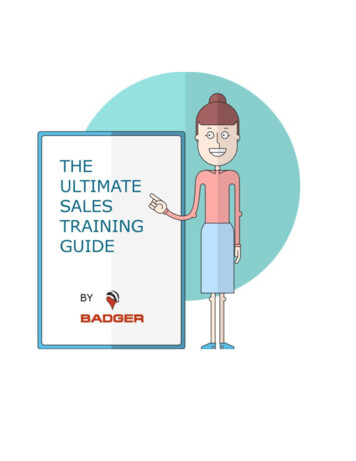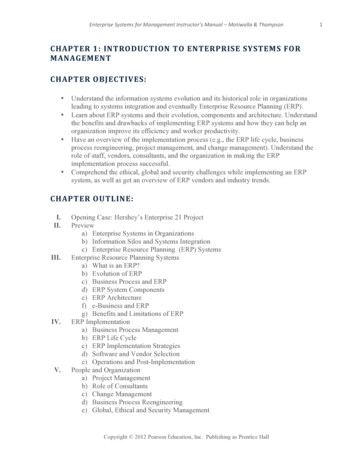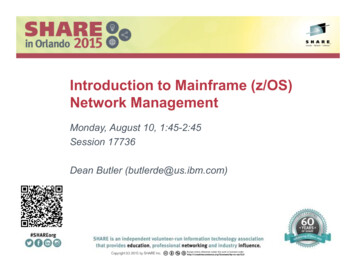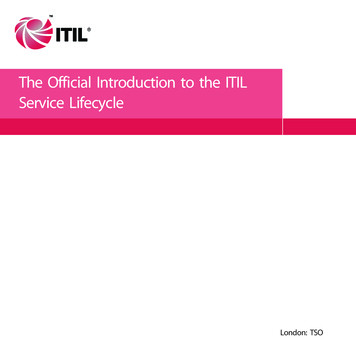
Transcription
1
IntroductionRevenue is the primary measure of your company’s success. Your revenue isdirectly related to your sales. That makes your sales team the lifeline of yourbusiness. If you want to drive results for your reps, team, and company - salestraining is the most important investment you’ll make. Companies in the U.S.feel the same way. They spend 20 billion a year training their sales reps.The problem is that sales training is a broad and complex topic. This guide isdesigned to be your complete sales training resource. Inside, you’ll findinformation on sales training types, programs, strategies, and more.Proper sales training will be an investment in reinvigorating your team andrevenue. Study this guide to make your sales training investment as valuable aspossible. 2
Table of ContentsTip: 1. Click on the topic you want to read.Tip: 2. To jump to the ‘table of contents’ anytime, click located on the bottom left of every page.IntroductionTable of ContentsChapter 1:What is Sales Training?Chapter 2:Why Should You Consider Sales Training?Chapter 3:Benefits of Sales TrainingChapter 4:How to Cut Your Sales Team’s Training Time in HalfChapter 5:Choosing your Sales Training ProgramChapter 6:Types of SalesTransactionalConsultativeChapter 7:Defining Your Sales ProcessLead Generation 3
QualifyingDemonstrating ValueConvincingClosingChapter 8:Types of Sales TrainingPublic vs Private Sales TrainingProduct Sales TrainingSales Methodology TrainingSales Skill TrainingSales Automation TrainingChapter 9:Product Sales TrainingProduct Sales Training OverviewYour Customer’s NeedsYour Product as a SolutionYour Competition (and how you win)Common Challenges of Product Sales TrainingProduct Sales Training Solution StrategiesCase-Based Learning:Point-of-Need Information:Knowledge Sharing:Chapter 10:Sales Methodology TrainingSales Methodology Training StrategiesConceptual SellingGiving InformationGetting commitmentSPIN SellingChallenger Sales ApproachChapter 11:Sales Skill TrainingSales Skill Training Fundamentals4
ConversationPresentationActive ListeningStorytellingBuilding RapportAssertivenessConquering ObjectionsClosingCross-Selling & Up-SellingSales Skill Training ExercisesCreate Call Plans:Practice Questions:Practice Story SharingPractice Sales Calls & ConversationSales Skill Training ProgramsDale Carnegie TrainingRAIN Sales TrainingRichardsonChapter 12:Sales Automation TrainingWhat is Sales Automation Training?Best Sales Automation ToolsCRM ToolsLead Generation ToolsBest Strategies for Sales Automation TrainingPilot the toolLet the company do it for youCreate Internal Training MaterialsSales Automation Training CoursesJohn BarrowsSalesHoodChapter 13:Sales Expert InterviewsJim Cathcart 5
Barb GiamancoDr. Christopher CronerDave KurlanDan McDadeDeb CalvertKen ThoresonCian McLoughlinRobert TersonFrank CespedesNicke WahlenOverallAbout Badger 6
Chapter 1What is Sales Training?It sounds self-explanatory. Sales training is the act of training your sales team.The definition gets complex when you consider how many types of sales thereare. A sales rep trained in telemarketing might not do well in field sales.Not to mention the techniques, productknowledge, and mindset that create thecore of a successful salesperson.Sales training that works is aninvestment that reinvigorates your teamand revenue. It will be suited towardyour industry and personalized for yourbusiness.The training itself can be a motivationalseminar or an in-depth workshop. Sales reps can be trained one-on-one or in agroup. Your reps can even use sales exercises to train each other for practicallynothing. 7
Chapter 2Why Should YouConsider SalesTraining?A lot of sales reps start their careerwithout any training at all. The sinkor-swim nature of sales creates theidea that good performance isintuitive. You either swim (and sell)or sink (and fail).It’s true, sales is a difficult career.That being said, you don’t need natural talent to succeed. Like all difficult things,salesmanship can be learned - even mastered - with the right training.Considering the fact that is costs an average of 114,957 to replace a sales rep,throwing your sales team a life preserver can benefit your entire organization.Investing in sales training sends a positive message to your sales team. It showsinterest in their performance, results, and careers. It also happens to be theperfect recipe to bring out the top-performers on your team.Before we dive into the fundamentals of proper sales training, we need to cover 8
how to choose the right program for your team. Defining your sales process isthe best way to understand how to improve it.Chapter 3Benefits of Sales TrainingSales Training has numerous benefits, both for your sales team and companywide. The importance of sales training is well-documented. Recent statisticsshow how essential a well-trained sales team can be for the bottom-line of yourorganization.50% of reps give up the1st time a prospectobjects, withoutattempting to build arelationship or keep intouch.66% of all salespeoplemiss their quotaOver half of all salespeople close at less than 40%40% of salespeople don’t understand their customer needs. 9
It takes an average of 8 cold call attempts to set a meeting with a prospectContinuous training gives 50% higher net sales per employee77% of executive buyers claim salespeople don’t understand their issues andwhere they can help, and 78% claim salespeople do not have relevant examplesor case studies to share with them.A well-trained sales team has a dramatic impact on company performance, not tomention the individual benefits. After receiving sales training, the sales activity ofa rep increases drastically.Sales training inspires and motivates your team, making them eager to practicetheir new skills and engage customers. Increased customer engagement equalsmore overall sales, an effect that compounds over time.Sales training has the added benefit of improving confidence, especially whenreps are trained by an authority-figure in sales. Confident reps will naturally sellmore. Combining the increased confidence of sales training with the strategiesyour sales team learns is a definite recipe for success. 10
Chapter 4How to Cut Your Sales Team’s Training Time ByHalfSales training is only half the battle. Your reps need to be efficient and productiveas quickly as possible. Maintaining your sales team’s focus throughout the salescycle can be a balancing act in itself.So much time and money is invested intohiring and onboarding sales reps that anydecrease in the amount of time spentselling will eat into your company’s profit.Unfortunately, only 39% of a sales rep’stime is spent selling or interacting withprospects and customers.The time sales reps spend on pre-saleand post-sale activities has increased15%. Time spent on non-salesadministrative work is up 21% as well.This paints an unfortunate picture forproductivity. Why invest time and money 11
into sales training when your team spends so much time not selling?L’Oreal asked a similar question when they examined their onboarding process.Their solution was to find a way to reduce training time while maintaining scaleand sales efficiency.The L’Oreal sales team adopted Badger Maps as their solution, reducing theirtraining time for new reps by 50%.L’Oreal reps were taking an average of 1 year to reach full productivity. Badgerreduced total training time to 6 months. Badger acts as L’Oreal’s trainingprogram by educating new reps on territory, customers, and best practices.Badger Maps allows new reps to learn sales essentials at a much faster rate.Customer information, routes, and new leads are provided directly throughBadger. This process saves L’Oreal valuable time that can be invested into agreater ROI for the sales team.The key to efficient sales training is overcoming problem areas. Whether repsneed guidance in product knowledge, methodology, technique, or improvingperformance in the field - facing these obstacles head-on is the best way todevelop a master sales team. 12
Chapter 5Choosing your Sales Training ProgramChoosing the sales training programthat’s right for your company dependsentirely on your sales process. Yoursales process is the customer-facingside of your business. Everythingleading up to (and resulting in) a sale isconsidered part of the process.What type of business are you? Thesales process for a b2b company isdifferent than that of a consumer-facingbusiness. Leads are gathereddifferently, there are more decisionmakers, and a distinct form of productknowledge is required.Choosing a sales training programthat isn’t the right fit for your business islike throwing money away. Here’s abrief overview on how to define yoursales process to make sure yourtraining investment is well-spent. 13
Chapter 6Types of SalesThere are generally two types of sales. Your salesprocess might involve a bit of both. Narrowing downthe elements you rely on from each will show youwhat your sales training should focus on.TransactionalA transactional sale is simple and short-term. Thesetypes of sales require less trust from the consumer.The buying decision is heavily influenced by impulse.The elements of a transactional sale to keep in mind:-Sale based on price, features, and availability-Buyer’s enjoy comparing and negotiating, priceshopping-Sell in high volume at low price-Requires customers ready to buy nowTransactional sales are less complex. They involve commodities and impulsebuys. Salespeople who thrive in transactional sales are able to quickly recallproduct knowledge and competitor pricing while maintaining an upbeat attitude.ConsultativeThese are complex and long-term sales. They are often service or solution basedand require trust between buyer and seller.-Sale based on value and benefits-Buyer’s often afraid of making the wrong choice14
-Sell in low volume at high price.-Requires educated customersConsultative sales are high pressure. They require reps who can understand andeducate consumers while building a strong sales relationship. 15
Chapter 7Defining Your SalesProcessDefining your sales process withthe above sales knowledge inmind is essential. Any one area ofyour sales process might bebased in transactional orconsultative sales. Examiningwhat’s working and what isn’tshows you on the type of salestraining you’ll need.Look for improvements that can be made in these areas of your sales process:Lead GenerationFinding your customers, or helping them find you. This might be accomplishedthrough cold calling, advertisements, inbound marketing, or other forms of leadgeneration.Lead generation is the most essential part of the sales process. If you don’t havecustomers coming in you’ll have a tough time selling anything.There are two types of leads:ColdThese are people you’ve either cold called, emailed, or approached blindly.16
These are leads who haven’t shown any interest in what you sell.WarmThese are prospects that have shown interest. They might find you yourcompany naturally or be a cold lead that you’ve built a relationship with.Your sales team needs to interact with leads with a strategy based on howthey’re collected.QualifyingReaching out to the list you’ve created. This is the part of your process whereyour leads are contacted.Qualifying your customers is just confirming their interest. You’re making surethat your business fits their needs so that neither of you wastes any time. Sometransactional sales might end here.Demonstrating ValueCommunicating the value of your product to your buyer. Value demonstrationbecomes more effective as your sales rep learns about your buyer.This is where sales skills come into play. Your buyer needs to be educated onhow your product will improve their life. Communicating the value of the productis a sales reps primary job.ConvincingGetting a decision from your buyer. Conquering objections is a key part of theconvince phase.Your prospect will have doubts or fears about their decision. Convincing yourbuyer requires building trust and communicating value to them.ClosingThe actual sale. This will vary depending on the complexity of your sale.Contracts might be finalized or new terms agreed on. 17
A sale doesn’t end when it’s closed. Relationship management is an importantpart of keeping your customers happy and coming back. 18
Chapter 8Types of Sales TrainingPublic vs Private Sales TrainingPublic sales training programs are events or seminars that involve a presenterand an audience. They can be motivational or cover a general sales systemfocused on improving revenue. A presentation can be a great motivational toolfor transactional salespeople.Private sales training is much more in-depth. Your team will receive personalinstruction on the sales skills and methodology suited to your industry. Privatetraining is a good idea if long-termcore improvement is needed. 19
Product Sales TrainingProduct sales training is your sales team’s knowledge of the product they selland how it fits into the lives of your customers. Any sales rep can benefit fromgreater product knowledge.Sales Methodology TrainingSales methodology training improves the approach your sales team is takingthroughout the process.Your methodology is how you collect, handle, and retain customers.Sales Skill TrainingSales skills can be thought of as how well your team is carrying out their salesmethodology.Sales skill training focuses on the nitty-gritty of sales. Communication skills andselling techniques are personally taught and usually supported by live practice.Sales Automation TrainingSales automation training involves making your reps more knowledgeable aboutthe tools they use. Lead generation and CRM software are necessarycomponents of any sales process.Learning how to use them effectively is an important part of sales training that isoften passed over.Each type of sales training is catered toward a specific stage of your salesproces
Sales Training has numerous benefits, both for your sales team and company-wide. The importance of sales training is well-documented. Recent statistics show











